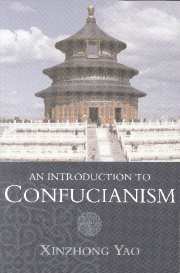Book contents
- Frontmatter
- Contents
- List of illustrations
- Preface
- Confucianism in history: chronological table
- Introduction: Confucian studies East and West
- 1 Confucianism, Confucius and Confucian classics
- 2 Evolution and transformation – a historical perspective
- 3 The Way of Confucianism
- 4 Ritual and religious practice
- 5 Confucianism and its modern relevance
- Select bibliography
- Transliteration table
- Index
- Plate section
2 - Evolution and transformation – a historical perspective
Published online by Cambridge University Press: 05 June 2012
- Frontmatter
- Contents
- List of illustrations
- Preface
- Confucianism in history: chronological table
- Introduction: Confucian studies East and West
- 1 Confucianism, Confucius and Confucian classics
- 2 Evolution and transformation – a historical perspective
- 3 The Way of Confucianism
- 4 Ritual and religious practice
- 5 Confucianism and its modern relevance
- Select bibliography
- Transliteration table
- Index
- Plate section
Summary
Confucianism has been in a continuous state of development, from the past to the present and onward into the future. To introduce Confucianism as a tradition we need a historic perspective. In this perspective, Confucianism consists of several main ‘stages’, which together forge the links of a long chain; each link of the chain shares common features with, yet differs from, others, which enables us to appreciate the continuous evolution and development of the whole tradition.
CONFUCIANISM AND THREE OPTIONS
The Spring and Autumn period and the Warring States period were times when the old order was breaking up and the new one was not yet established. Many thinkers ‘pondered’ about just how to save the world from collapse and about how to lead a meaningful life in such a chaotic environment. Various proposals and opinions were thus put forward. These proposals and theories can be conveniently classified into three central groups, each pointing in a different direction.
The first group proposed that all social conventions and institutions must be abolished in order to have a peaceful and harmonious life: ‘Abandon sageliness and discard wisdom; then the people will benefit a hundredfold. Abandon humaneness (ren) and discard righteousness (yi), then the people will return to filial piety (xiao) and fraternal love (ti)’ (Dao De Jing, 19).
- Type
- Chapter
- Information
- An Introduction to Confucianism , pp. 68 - 138Publisher: Cambridge University PressPrint publication year: 2000

